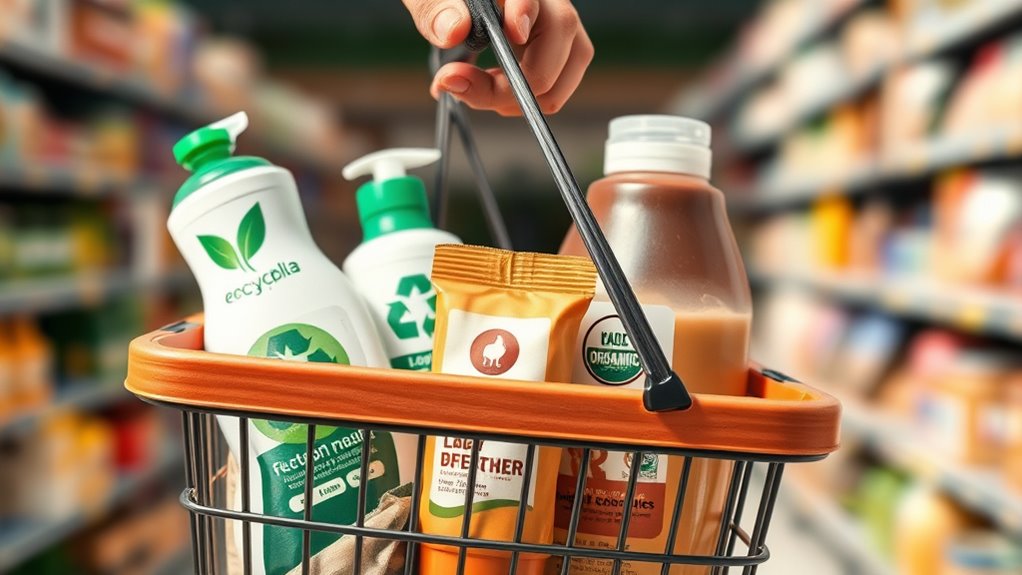To decode eco-labels, start by recognizing reputable certifications like USDA Organic or Fair Trade, which show trusted standards. Look at symbols that indicate recyclability, biodegradability, or cruelty-free testing, but always check accompanying details for clarity. Examine packaging and brand information to confirm transparency and standards. Develop a critical eye for claims, focusing on credible marks rather than just symbols. Keep learning about what each label truly represents—continuing here helps you make more ethical, informed choices.
Key Takeaways
- Learn to identify credible eco-labels by researching certifying organizations and understanding their standards.
- Examine packaging for clear certification details, standards, and the scope of sustainability claims.
- Recognize common eco-symbols like recycling, water efficiency, or biodegradability icons, and verify their meaning.
- Read accompanying explanations or visit brand websites for transparency beyond symbols on packaging.
- Develop a critical mindset to distinguish trustworthy labels from misleading or vague sustainability claims.

Have you ever wondered what those eco-labels really mean when you see them on products? It’s common to spot various label symbols on packaging, but understanding what they signify isn’t always straightforward. Many consumers assume these labels guarantee environmental friendliness, but in reality, they represent a range of certifications and standards that can differ considerably. To make informed choices, you need to learn how to decode these symbols and recognize what they stand for.
Eco-labels vary widely; understanding their meanings helps you make truly sustainable choices.
Sustainable certifications are a good starting point. These are official recognitions granted by independent organizations after a product has met specific environmental and social criteria. For example, labels like USDA Organic or Fair Trade certify that certain standards were met in farming practices, worker conditions, or resource management. When you see these certifications, it’s a sign that the product has undergone rigorous evaluation. But keep in mind, not all eco-labels are equally trustworthy; some may be more rigorous or transparent than others.
Next, pay attention to label symbols. These visual cues are designed to quickly convey information about a product’s sustainability attributes. Common symbols include the recycling triangle, which indicates recyclability, or water and energy efficiency icons that show how a product minimizes resource use. Sometimes, labels feature icons related to cruelty-free testing or biodegradable materials. Recognizing these symbols helps you quickly assess whether a product aligns with your values. However, since symbols can vary by country and manufacturer, it’s wise to read accompanying explanations or certifications to fully understand what they mean.
Another key aspect is to look beyond the symbols and check the details provided on the packaging or the brand’s website. Reputable eco-labels often include information about the standards they follow, the certifying body, and the scope of the certification. Some labels are more extensive, covering multiple aspects like carbon footprint, water usage, and fair labor practices. Others might be more limited or industry-specific. Learning to differentiate between these helps you avoid misleading claims and choose genuinely sustainable products.
Additionally, understanding Credit Card Processing & ISOs can help merchants and brands better manage their reputation and transparency efforts, which may influence their eco-labeling practices. Ultimately, decoding eco-labels isn’t about memorizing every symbol but developing a critical eye for the information they communicate. Recognize the most credible sustainable certifications and understand what label symbols indicate about a product’s environmental impact. By doing so, you empower yourself to shop ethically and support brands committed to transparency and sustainability. Remember, the more you learn about what these labels mean, the easier it becomes to make choices that align with your values and contribute to a healthier planet.
Frequently Asked Questions
How Reliable Are Eco-Labels Across Different Countries?
Eco-labels’ reliability varies across countries due to differences in third-party verification and certification consistency. When you see labels backed by independent organizations, they’re more trustworthy, but not all countries enforce strict standards. It’s smart to research the certifying body and look for internationally recognized labels. By doing so, you guarantee that the eco-labels you rely on genuinely reflect sustainable practices, regardless of where they’re issued.
Can Eco-Labels Guarantee Completely Sustainable Products?
You might think eco-labels guarantee perfect sustainability, but don’t be fooled—they’re not foolproof. The truth is, certification accuracy varies, and brand transparency can be questionable. Eco-labels offer helpful guidance, but they can’t promise completely sustainable products. Instead, see them as a useful tool to make more informed choices, understanding that some greenwashing exists. Always dig deeper and stay skeptical—perfection in sustainability is a moving target.
Are There Hidden Costs Associated With Eco-Labeled Products?
You might worry about hidden expenses with eco-labeled products, but it’s important to contemplate greenwashing risks. Sometimes, labels can be misleading or only partially accurate, which can mask the true sustainability costs. While eco-labels aim to promote ethical shopping, they don’t always guarantee complete transparency. Be aware that hidden costs, like higher prices or limited product choices, can still exist despite the eco-label, so always research thoroughly before purchasing.
How Often Are Eco-Label Standards Updated or Reviewed?
You might wonder how often eco-label standards are updated or reviewed. Typically, certification renewal and standard revision cycles happen regularly to make certain products meet current environmental and social criteria. These cycles can vary from annually to every few years, depending on the certification. Staying informed about these updates helps you verify that the eco-label remains trustworthy and reflects the latest sustainability practices.
Do Eco-Labels Consider Social and Labor Practices?
Eco-labels often consider social responsibility and labor standards, but it varies by certification. When you see eco-labels, check if they include criteria for fair wages, safe working conditions, and workers’ rights. Some labels emphasize environmental impact but may overlook social issues. To make ethical choices, look for certifications that explicitly address social responsibility and labor standards, ensuring the products you buy support fair treatment and ethical labor practices.
Conclusion
Decoding eco-labels might seem tricky at first, but it’s worth the effort. By understanding what labels like FSC or Fair Trade mean, you make more ethical choices effortlessly. Did you know that products with eco-labels are growing 20% annually? That’s a clear sign your small, informed decisions can drive big change. So next time you’re shopping, use these labels as your guide—your choices can help protect the planet and support fairer practices worldwide.








